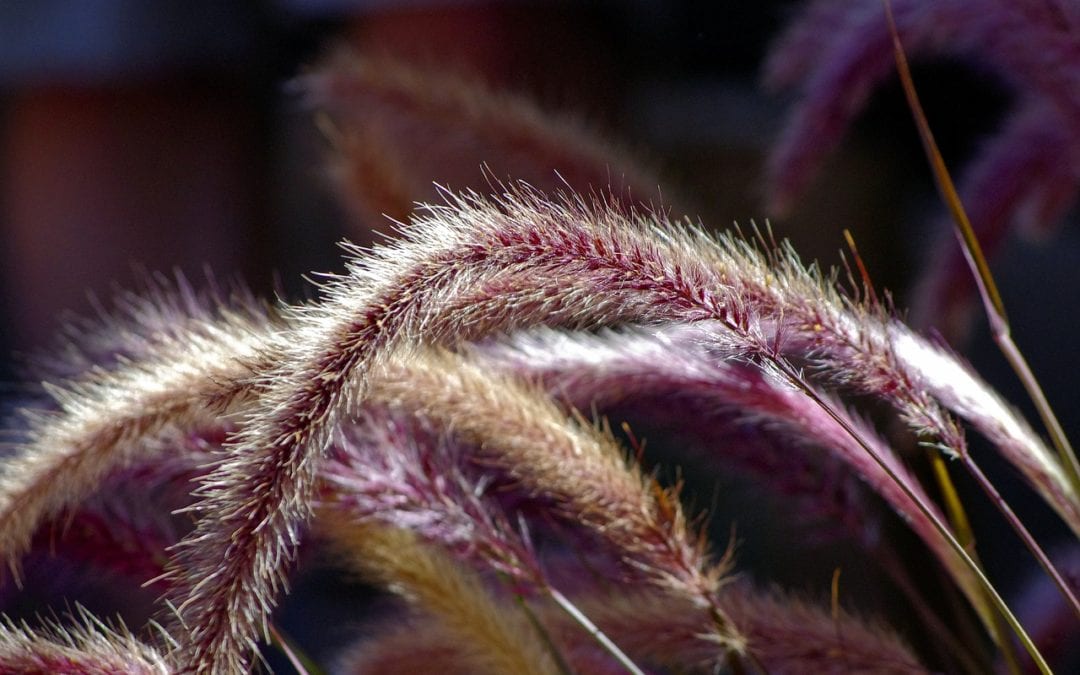Native ornamental grasses are a terrific way to add texture, height, and some gorgeous interest to your landscapes. If you’ve never looked into these naturally beautiful specimens, it’s time to take a gander at ornamental grasses.
5 Reasons to try Native Ornamental Grasses in San Antonio
1. Ornamental grasses are easy care.
- Very little maintenance is required throughout the growing season for ornamental grasses.
- An early spring pruning each year and digging and dividing the grasses every 3 years or so is about all you need to use your pruners for with ornamental grasses.
2. Ornamental grasses provide architectural interest to your landscapes
- The slender, arching, foliage of ornamental grasses create height, and texture for a visually pleasing aesthetic.
- In lieu of flowers or blooms, many ornamental grasses produce striking, feathery plumes. (These look stunning when backlit by either landscape lights or the natural sun streaming through.)
3. Ornamental grasses have litte to no pest or disease issues.
- While you may find yourself battling the pests that surge in forces once the weather heats up early summer, your ornamental grasses will skate through the summer unscathed.
4. Native ornamental grasses provide for our native wildlife.
- If you choose native ornamental grasses, you offer food, nesting and cover for many species of our native wildlife. Come see our selections!
5. Ornamental grasses are low water users. Enough said!

Pampas grass is one of our most popular ornamental grasses.


Pink Muhly is absolutely stunning in fall when backlit by the sunlight.
How to Plant Ornamental Grasses in San Antonio, Texas
1. Plant perennial ornamental grasses in fall, annual ornamental grasses in spring.
2. The majority of ornamental grasses prefer to be planted in sunny, well-draining sites. (There are always exceptions to light requirements for plants; read up on the ornamental grass you are interested in.)
3. Most ornamental grasses aren’t overly picky about the soil. A mixture of 50% low end potting soil, or Jungleland Flower and Vegetable soil, to 50% native soil is a good mix to plant ornamental grasses in.
4. Dig your hole for ornamental grasses at twice the diameter of the pot it is growing in and only as deep as the soil line in pot it is currently growing in.
5. Remove the ornamental grass from the growing container. If the roots have been circling in the pot and are tightly wound, use your fingers and rub along the roots to rough them up a bit. This helps the roots spread out into the soil.
6. Place ornamental grass into the hole where the top of the soil on the plant is level with the top of the soil on the ground. Adjust by adding or removing soil to get a nice level.
7. Fill in soil around the roots about halfway up the plant and then fill the hole with water and allow it to seep all the way into the ground. (This helps to eliminate air pockets around the roots.)
8. Fill the rest of the hole in with remaining soil and tamp it down firmly but gently.
9. Water your ornamental grasses again immediately after planting. Water every other day for the first week after planting, gradually increasing time in between watering. By week 3 after planting, twice a week should be sufficient, and after that once a week or once every two weeks depending on rainfall. A year after planting, you most likely can leave it up to rain to water your ornamental grasses.
10. You really don’t need to worry about fertilizing ornamental grasses. If you do wish to fertilize, do so only after pruning back in late winter/early spring. Use a slow-release fertilizer to spread at nutrients over time rather than a big dose that could make it grow to fast and end up flopping over. Base your decision to feed on the color and vigor of the plant.
The Happy Gardener, Lisa Mulroy


All the rain damaged my ornamental grass. I hacked off the dead part and now it is 1/2 if what it was. Is there a chance it will make it?
There could be a chance. How long have you had the grass? Is this a newly planted specimen or have you had it for a couple of years. What is the soil like in that area? It might be a problem with drainage. If it is taking more than 36 hours to drain free of standing water that will be an issue for the remainder of your grass. If that is the case, you might think about digging it up and assessing the roots to make sure they are still viable to plant your grass somewhere else. (Roots would need to be healthy looking, white, light yellow, not black and shriveled…a sign of root rot.) If the roots are damaged and have succumbed to root rot, you may have to start over with a new plant in a new place.
What type of ornamental grasses are good for part sun to shade?
Yvette,
Oh gosh, I’m so sorry that your comment slipped by me. Some ornamental grasses for part sun are: Inland Sea Oats, Karl Foerester Feather Reed Grass, different varieties of Carex grasses, Liriope. If you have more part sun than shade, you could expand to some gulf muhlys
are at tails considered an ornamental grass
Hi there,
Many different species of plants are kind of lumped into “ornamental grass” options. However, true ornamental grasses are in the Poaecea family. We also generally include plants in the families: Juncaceae (rushes), Cyperaceae (sedges), and Typhaceae which cattails are in. So…yes? Ha! Cattails are generally found in marsh areas and love water, so keep that in mind when planning on planting them. They are so much fun though! Heres’a little Youtube video that gives some more info on cattails. When we get them in stock, they are usually located in our water plant sections. Call ahead to check for availability.